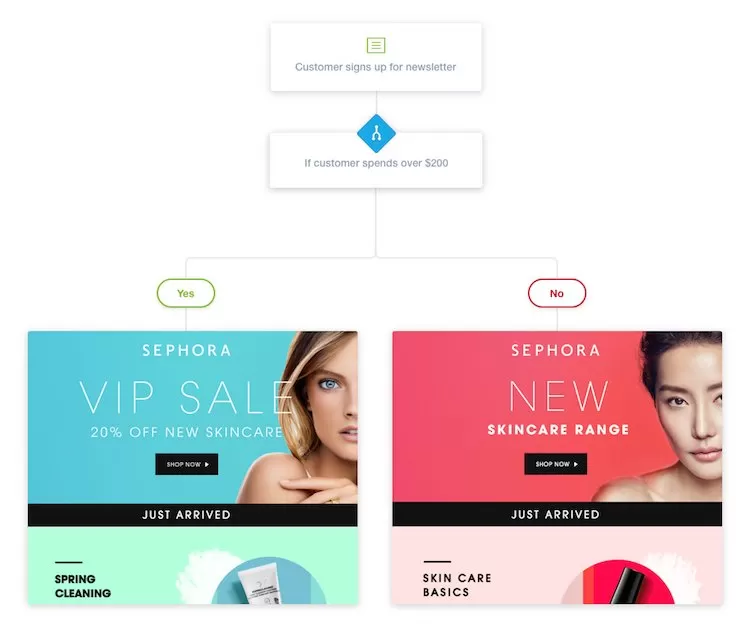Hyper-personalisation has changed marketing from the bottom up. First, you need to appreciate the distinctions between hyper-personalisation software improving the customer experience, and, in turn, making businesses more profitable. Yet, many fail at implementation. So it is important to appreciate the benefits of hyper-personalisation in case the value of making the effort isn’t understood. Less appreciative people still believe personalisation is merely adding a first name to email subject lines and in so doing believe that the personalised marketing box is ticked. Some are so confused they don’t even try. So here, we will try to clear up some questions surrounding hyper-personalisation, and what it takes to get right.
What is marketing hyper-personalisation?
Marketing hyper-personalisation or one-to-one marketing, is the practice of using first-party data to deliver brand messages targeted to an individual prospect. This method differs from traditional marketing, which mostly relies on casting a wide net, to earn a small number of customers. With billboards, cold calls, segmented emails, and more, traditional marketing emphasises the number of messages over their relevance. Analytics has become much more sophisticated and data on individual prospects has grown exponentially. Today, marketers take advantage of both to deliver prospects the most relevant message at the ideal time.
Why hyper-personalised marketing?
If you’re a traditional marketing mind, you may wonder why businesses are out with the old and in with the new. In plain terms, it started with consumers, who, after years of bombardment with irrelevant marketing emails, began tuning out.
They hung up on the telemarketer, they flipped the channel as meaningless ads permeated their lives: in cars, offices, and even homes. Soon, they couldn’t escape the feeling that businesses didn’t want to help solve their problems. Businesses wanted to make money, even if it meant interrupting a family dinner or the Super Bowl. That perception lingers today. Research shows that 63% of consumers are highly annoyed with the way brands continue to blast generic advertising messages repeatedly.
What customers want, instead, is marketing hyper-personalisation. According to an Epsilon survey of 1,000 consumers aged 18-64:
- 80% say they are more likely to do business with a company if it offers hyper-personalised experiences.
- 90% claim they find hyper-personalisation appealing.
More than half of consumers even say they’re willing to hand over their personal information, so long as you use it to benefit them. So, how do you use it to benefit them?
Marketing hyper-personalisation strategies
It’s not easy to determine the benefits your customers are seeking at any moment. The reason, primarily, is that those specific benefits vary from situation to situation, business to business. However, there are three common strategies that every brand can build off of to ensure they create a strong hyper-personalised marketing plan:
- Know their needs. Every customer expects you to know their needs. When they punch a long-tail query into your search bar, they expect content that answers it. If they’re shopping in a brick-and-mortar location of yours, they probably want details on a product. At every touchpoint throughout the funnel, ask yourself, “What does the customer want here? What are they looking for?” Or, even better, ask them. Surveys and user testing are an easy way to discover these answers. Some solutions offer comprehensive fulfilment of these needs capturing data from visit navigation and clicks on your site to determine exactly which products have the highest potential to be purchased next by each consumer.
- Remember who they are and what they’ve done, on any channel or device. On the list of things that frustrate consumers, siloed communication is near the top. If they’ve coordinated a date and time for a demo of your product via phone, and the next day, they get an email aiming for a demo sign-up, that’s a bad user experience. Not only is it annoying, but it has the potential to confuse the prospect. He or she may think: “Did something go wrong? Was my demo cancelled? Are they trying to reschedule?” Or, another example: They download an ebook, and later that week, get an email attempting to get them to download that same ebook. Again, this is a bad user experience.
Your hyper-personalisation strategy should span every device and channel, and your CRM should reflect anything you’ve learned about your prospect along the way. Avoid scenarios like those above, and instead, aim to know exactly what your prospects have done, the kind of messaging they’ve responded to, the type of content they like, their communication preferences, and more.
- Anticipate their future needs. If you have the advantage of knowing their personal details and browsing behaviour, you have the power to predict what’s coming next. Think of when you book a flight somewhere. Airlines don’t stop after selling you a ticket. They ask if you want travel insurance; they ask if you want to book a hotel room; they ask if you’ll need to rent a car, etc. They know you’re travelling, and they also know the experience is more than just flying. The same goes for your product or service. What add-ons might they need? What upgraded versions might they consider? This extends before and after the buying stage, too.
If you know they read a lot of your content on social media marketing, send them more content about social media marketing. Send them blog posts, podcasts, ebooks, and tip sheets. If they’ve already bought your product, make them aware of newer versions, bug fixes, and use cases that help them take advantage of its full potential. Successful hyper-personalisation in the funnel is like playing chess. You have to think several moves ahead.
Benefits of hyper-personalised marketing
The preceding are strategies, and when you start perfecting them and tweaking them with more data, your customers start to see the following benefits, which apply to all businesses:
- They get relevant content. Consumers don’t hate advertising; they hate bad advertising. They hate irrelevant brand messaging. Since hyper-personalised content is based on past behaviour, it’s more likely the consumer will respond favourably to its message.
- They’re reminded of their recent browsing history. Remarketing is creepier in theory than in practice. Data has shown that, up to a point, the more you remarket your products, the more likely your prospects are to buy them. The reality is, people are distracted even when they’re buying. Their boss will walk in; they’ll get phone calls. Maybe they realised, at checkout, that they didn’t have as much money in their account as they thought. Whatever the reason, remarketing is a good way to combat it. When done right, it’s not annoying or creepy — it’s simply a reminder that says: “Hey, don’t forget, you were looking at this earlier. Maybe you’re ready to buy it now.”
- They receive valuable suggestions. Consumers don’t just benefit from reminders of products they’ve already seen, but of new ones they may not have realised exist. These could be add-ons, upgraded versions, or related content. Once you’ve anticipated your prospects’ needs, the next step is showing them what they need before they need it, with emails, ads, blog posts, etc.
- They get information when they need it. Content relevance is crucial, but delivering it at the right time called send time optimisation, is even more so. Don’t just think “what?” Think “when” too.
On a broad scale, this could be blog posts optimised for popular keyword search terms throughout each stage of the marketing funnel. On a more granular level, it may look like a chat module that allows your business to respond to customer issues immediately. The sooner you make yourself available, the better, research has found. According to a study on lead response time, the chance of converting a lead is 100 times greater if contacted within five minutes. The more data you gather, and the deeper you dig, the more you’ll discover what your leads are looking for when they make contact. And once you’ve done that, you can serve them what they need the moment they need it.
The tools for hyper-personalisation
The biggest challenge of hyper-personalisation is scaling it. No matter how many people work in your marketing department, you can’t manually create an email for every customer. You can’t manually create an ad for every prospect. But, you have to maintain that appearance, and that requires the right tools. For starters, here’s what you’ll need:
- platform: Analytics platforms aid in the collection of data, which every marketer relies on to create hyper-personalised campaigns. As opposed to the self-reported data like name and email address — the “who you are” data — the data collected by most analytics platforms is behavioural. It’s the “what you do” data, which can be even more valuable than the former. Platforms like Google Analytics, Heap Analytics, and Crazy Egg are popular in this category. (it is important to keep an eye on your email attribution here, as everyone claims the source is theirs).
- Data management platform: Data management platforms hold audience and campaign data from sources involved in programmatic ad buying. For marketers, it’s a one-stop location where they can manage user data to create targeted user segments for digital advertising campaigns. You must appreciate that segmentation has had its day and hyper-personalisation delivers a 20-fold higher return.
That user data could be, for example, age, household income, browsing habits, purchasing behaviour, demographics, location, device, and more. Then, the DMP can analyse the performance of those segments and assist in the optimisation of future campaigns.
- Customer relationship management software (CRM): Your CRM is the hub of customer information. Anything you learn about a prospect from lead capture forms, sales calls, or third-party data providers should be logged here. When connected with the rest of your marketing stack, it will allow your other tools (like a post-click landing page platform) to feed its prospect information, and, in turn, it can feed that information to an email marketing platform, which will help hyper-personalise your emails even further. Beware the legalities here, as the UK, Europe and the US have significant data-protection penalties if you fall foul, and worse your customers will take their business elsewhere.
- Post-click landing page platform: Without a post-click solution, it all falls apart. This is your best way to capture prospect data today, so without it, you can kiss hyper-personalisation goodbye. It’s also the best tool you have to move customers to the next stage of the funnel.
- Email marketing platform: Today, email marketing platforms are a staple of every marketing technology stack, as the channel reigns supreme as the number one most profitable for businesses. That’s not surprising, considering email address is a piece of information easily offered up by prospects. Through this channel is how most people prefer to be contacted. And according to recent research, getting emails opened comes down to how well you hyper-personalise them.
Consumers say they’re more likely to respond well to an email if it looks like it’s made for them. Dynamic content can accomplish this, as can segmenting, but twenty times less effectively as it is with triggered email solutions too. And it doesn’t even have to be that complicated. If a consumer receives an email that is unique to their relationship with your site, you should appreciate the power this has over the very best alternative, showing them anything else.
Digital advertising
When creating any form of internet advertising, hyper-personalisation is paramount. Internet users respond to relevance and trust. Anything outside of that won’t earn conversions.
To establish relevance and trust through hyper-personalisation, every campaign’s ad and post-click landing page must match. That means headlines, imagery, logos, and brand colours. Together, these reinforce your brand identity and assure visitors that they’re in the right place while delivering what was promised in the advertisement.
Today, businesses can work marketing magic with email. Messages via this channel are non-invasive, they’re easily consumable, and they’re also highly customisable. Using dynamic content, email subscribers can receive offers uniquely tailored to their demographics, psychographics, firmographics and behaviour. Here’s a great example of dynamic content from Sephora, which has this particular campaign set to deliver one email if the recipient has spent more than $200, and another if they don’t.

Social media
While it was once a one-way photo and text-blasting to followers, social media has become highly personalised. Likely, you’re familiar with Facebook’s “trending” bar, which is tailored to the behaviour of prospects. Its Meta Pixel is also one of the most powerful retargeting tools in marketing. Implanting it on the back end of a web page allows marketers to target people on Facebook who didn’t convert.
Other examples of increasing hyper-personalisation are Snapchat’s geo-filters and games, Twitter accounts dedicated to individualised customer support, and recently, Instagram’s newest emoji slider feature, which allows account holders to poll their followers. In that poll (pictured below), the emoji can be slid from left to right to indicate how strongly a user agrees or disagrees. That information can then be used for more personalized content in the future.
Start implementing your hyper-personalised marketing
McKinsey research shows hyper-personalisation reduces acquisition costs by as much as 50%, lifts revenues by 5-15%, and increases the efficiency of marketing spend by 10-30%. On the flip side:
- Irrelevant content generates 83% lower response rates in the average marketing campaign.
- Lack of hyper-personalisation and trust cost businesses $756 billion last year.





